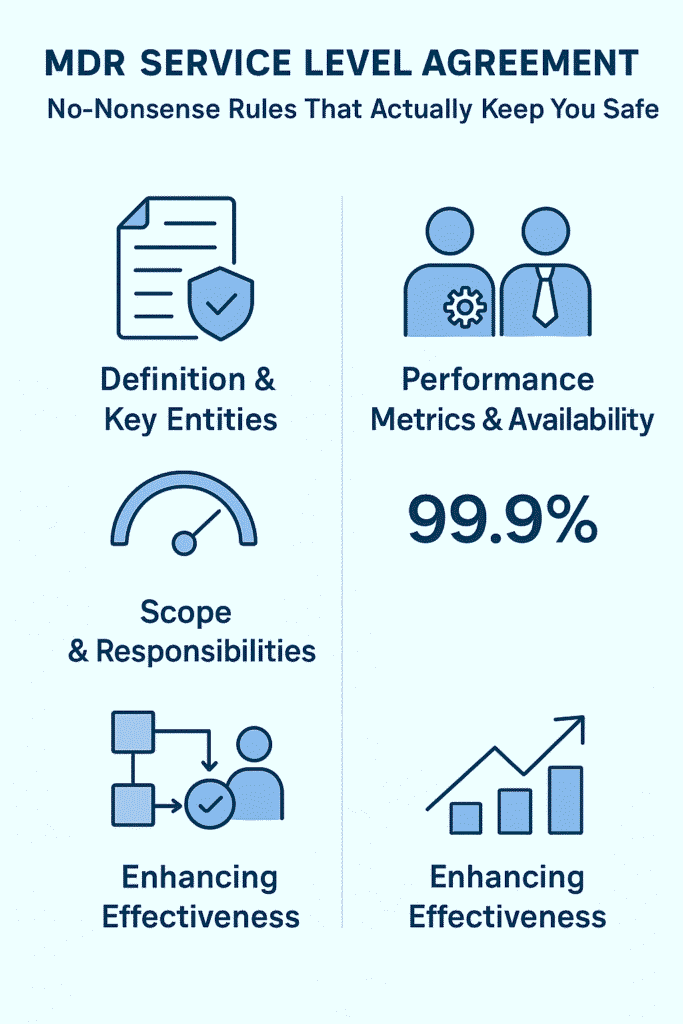Address
304 North Cardinal St.
Dorchester Center, MA 02124
Work Hours
Monday to Friday: 7AM - 7PM
Weekend: 10AM - 5PM
Address
304 North Cardinal St.
Dorchester Center, MA 02124
Work Hours
Monday to Friday: 7AM - 7PM
Weekend: 10AM - 5PM

There’s something fascinating about how a simple document transforms chaos into order. Behind the dry language and metrics of MDR service agreements lies a system that might mean the difference between a minor hiccup and a major breach.
Companies sign these agreements expecting 24/7 protection, and that’s exactly what they should get. The MDR provider puts everything in black and white, from how fast they’ll spot suspicious activity to what happens if they miss something big.

Most organizations don’t quite grasp what they’re getting into with Managed Detection and Response until that first thick SLA lands on their desk.
It’s not the most thrilling read, but it’s probably the most important document they’ll ever get from their security provider , the one that actually says what they’re gonna do when things go wrong.
For example, in 2018, advanced attacks lingered undetected for an average of 204 days in the APAC region, 177 days in EMEA, and 71 days in the Americas (1). With an SLA in place, those numbers can drop dramatically.
It’s basically the playbook that keeps everyone honest. The provider says what they’ll do, when they’ll do it, and what happens if they don’t. Without one of these in place, you’re just hoping they’ll pick up the phone when something bad happens.
That’s why it helps to look closely at the mdr service levels spelled out in these agreements, since they define how consistent the provider really is.
Nobody likes surprises in cybersecurity (except maybe pen testers). The SLA puts everything in black and white, response times, coverage, the whole nine yards. And if the provider drops the ball? There’s usually a penalty or credit system built in.
In fact, SLAs across industries often include specific penalties, like 20% of the service fee, if availability drops below agreed levels (2)
Three main players make this whole thing work. There’s the MDR provider doing the heavy lifting with monitoring and response, the client organization that needs to stay in the loop and make quick decisions, and the Security Operations Center (SOC) running 24/7 like a high, tech lighthouse.
These folks are the ones who don’t sleep (well, they work in shifts). They’ve got to watch everything, spot the bad stuff, and jump on it fast. Critical alerts might need to hit the CISO’s phone within 15 minutes , that’s barely enough time to grab a coffee.
Both sides need to dance together on this one. When the provider spots something nasty, the client can’t ghost them , they need to be right there, ready to approve actions or provide context about what’s normal and what isn’t.
Think of the SOC as mission control, but for cybersecurity. These teams work around the clock, constantly updating their threat intel, watching for anything suspicious.
This is where the rubber meets the road , actual numbers for how fast things should happen. Mean time to detect, mean time to respond, and what counts as critical versus just annoying.
Some providers promise to spot problems in under 15 minutes and respond to the really bad stuff within 30. These aren’t random numbers , they’re based on how long it takes for an attacker to do serious damage.
At the core, this is what managed detection and response is about, measurable commitments instead of vague promises.
Not every alert means the sky is falling. Good MDR providers rank everything by how bad it could be, so the team knows exactly where to focus first.
The SLA spells out exactly what’s being watched , computers, cloud stuff, networks, email, even those smart coffee makers in the break room (if they’re connected to the network).
Without an SLA, security’s just a hope and a prayer. With one, you’ve got something solid to point to when things aren’t working right, and everyone knows exactly what’s supposed to happen when trouble shows up.

Credit: unsplash.com (Photo by Markus Spiske)
The numbers don’t lie. When talking about security metrics with MDR providers, vague promises of “quick response” just don’t cut it anymore. Real measurements, hard data points , that’s what matters.
Written in black and white, these metrics hold providers’ feet to the fire. No wiggle room, no excuses.
Most providers shoot for that magical 99.9% uptime figure. Around, the clock coverage means exactly that , eyes on screens 24/7/365, watching for trouble. No gaps, no blind spots.
Fresh intel flows in daily, sometimes hourly. The SOC teams need current data to catch new attack methods before they spread like wildfire.
There’s a pecking order to alerts. Big problems go straight to the top brass, while smaller issues follow the chain of command. Makes sense , different threats need different responses.
Nobody likes being left in the dark. Good SLAs spell out exactly when and how clients get updates. Quick heads up when something’s brewing, regular check-ins to keep everyone aligned.
Two types of reports hit the inbox: weekly nuts, bolts updates for the tech folks, monthly summaries for the corner office crowd. Plus, everything’s got to play nice with the alphabet soup of regulations (GDPR, HIPAA, PCI DSS, ISO 27001).
They’re keeping receipts , 12 months of quick access logs, another 2 years in cold storage. Perfect for those “what happened last summer” moments or when auditors come knocking.
MDR agreements need to spell out more than just basic coverage , they’ve got to nail down how everything works together and who’s on the hook for what.
The protection usually stretches across everything from regular computers to those industrial sensors nobody thinks about (until they break). Most providers throw in EDR tools, XDR platforms, and some fancy automated fix it systems that probably cost more than your car.
These services have to play nice with existing SIEM and SOAR platforms , it’s like getting your mom’s recipe to work in a professional kitchen. RMM tools need to link up too, making sure all the data flows where it should.
The provider’s team stays glued to their screens watching for trouble, while clients give the thumbs up for any major system changes. Both sides need to keep their hands clean when it comes to handling sensitive data.
Miss a deadline? That’ll cost you , providers typically fork over credits (around 5% per mess,up) each month when they drop the ball. It’s amazing how motivating a hit to the wallet can be.
Experience shows that cookie,cutter contracts don’t cut it , you’ve got to tailor these things like a custom suit.
Match those metrics to whatever keeps your compliance folks up at night. Generic numbers look nice on paper, but they won’t help when auditors come knocking.
AI’s getting faster, smarter, meaner , and that means response times keep shrinking. Plus, with everything moving to the cloud and IoT devices popping up like mushrooms, SLAs need to keep pace.
Keep those dashboards front and center and don’t skip the review meetings , catch problems while they’re still small enough to fix without drama.
Throw in some surprise attack drills and better threat intel sharing. Because knowing what’s coming beats cleaning up after it hits. Many clients also weigh the broader MDR benefits here, from stronger collaboration to a clearer view of their overall security posture.
We’ve seen firsthand that a well-crafted MDR SLA is more than a contract, it’s a living document that guides cybersecurity collaboration. Clear service expectations reduce friction, speed up response, and ultimately help keep organizations safer.
If your team is considering MDR services, take time to work with providers on SLA details that fit your needs and hold everyone accountable. That’s how you build a security partnership that stands strong when it matters most.
Start building your MDR strategy with our expert consulting, we help MSSPs streamline operations, reduce tool sprawl, and boost service quality. With 15+ years of experience and 48K+ projects complete.
Our team provides vendor-neutral selection, stack optimization, PoC support, and actionable recommendations to align your tech stack with business goals and operational maturity.
SLA service level objectives set clear performance goals. SLA root cause analysis digs into why incidents happen. SLA attack containment explains how providers limit the spread of threats. Together, they show how MDR agreements combine prevention, analysis, and control.
SLA MDR service channels outline how clients can connect with support. SLA incident closure criteria explain when cases are considered resolved. SLA MDR service benefits highlight accountability, communication, and measurable value that clients receive through their MDR agreements.
SLA vendor accountability means providers must take responsibility for results. SLA operational metrics MDR measure daily performance. SLA service credit policies create consequences if standards are missed. Together, they enforce transparency and fairness between clients and providers.
SLA MDR team responsibilities define who handles each task. SLA cyber threat visibility ensures threats are clear to both provider and client. In a security operations center, these elements support faster response, shared awareness, and consistent handling of attacks.